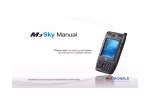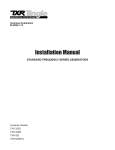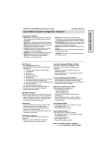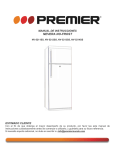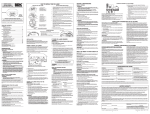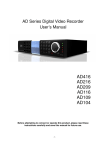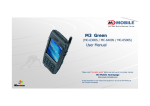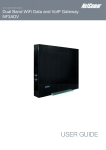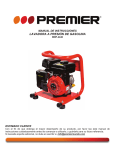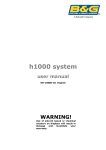Download - Frank`s Hospital Workshop
Transcript
Technical Publication OM-0269R5 Operation Movix 4.0 E+ Portable X-ray Units STEPHANIX 10 rue Jean Moulin, Z.I. du Bayon 42150 LA RICAMARIE FRANCE Tel : 00 33 4 77 47 81 60 Fax : 00 33 4 77 37 55 19 0459 Le marquage CE qui se trouve sur ce produit indique que celui-ci est en conformité avec la directive européenne des dispositifs médicaux 93/42/CEE This product bears a CE marking in accordance with the provisions of the 93/42/EEC MDD dated June 14, 1993. ¡ IMPORTANTE ! ... Protección ante los rayos-X LOS EQUIPOS DE RAYOS-X SON PELIGROSOS PARA EL PACIENTE Y EL OPERADOR A MENOS QUE LAS MEDIDAS DE PROTECCION SEAN ESTRICTAMENTE OBSERVADAS Si el equipo de rayos-X no se usa adecuadamente, puede causar lesiones. Por este motivo, las instrucciones aquí incluidas se deben leer y comprender en su totalidad antes de intentar poner el equipo en funcionamiento. Estaremos gustosos de asistir y cooperar en poner el equipo en marcha. Aunque el equipo está construido según las normas de seguridad más estrictas y presenta un alto grado de protección contra las radiaciones-X, ningún diseño practico puede ofrecer una protección completa. Tampoco ningún diseño practico puede obligar al operador a tomar las precauciones adecuadas para prevenir la posibilidad de que cualquier persona de manera descuidada, poco sensata o ignorante, se exponga a radiaciones directas o indirectas. Es importante que cualquier persona relacionada con radiaciones-X esté debidamente entrenada y tome las medidas adecuadas para asegurar la protección contra posibles lesiones. El fabricante asume que todo operador y personal de servicio autorizado para manejar, instalar, calibrar o mantener este equipo, es consciente del peligro que conlleva la exposición excesiva a las radiaciones-X, está suficientemente entrenado y posee los conocimiento necesarios para ello. Por lo tanto, el equipo aquí descrito se vende entendiendo que el fabricante, sus agentes y representantes no tienen ninguna responsabilidad en caso de lesiones o daños que puedan resultar de la exposición a dichas radiaciones. Existen diversos materiales y dispositivos protectores, cuyo uso es recomendable. IMPORTANT ! ... X-ray Protection X-RAY EQUIPMENT IS DANGEROUS TO BOTH PATIENT AND OPERATOR UNLESS MEASURES OF PROTECTION ARE STRICTLY OBSERVED X-ray equipment if not properly used may cause injury. Accordingly, the instructions herein should be thoroughly read and understood before attempting to place this equipment in operation. We will be glad to assist and cooperate in placing this equipment in use. Although this apparatus is built to the highest safety standards and incorporates a high degree of protection against X-radiation other than the useful beam, no practical design of equipment can provide complete protection. Nor can any practical design compel the operator to take adequate precautions to prevent the possibility of any persons carelessly, unwisely, or unknowingly exposing themselves or others to X-radiation. It is important that everyone working with X-radiation be properly trained and take adequate steps to insure protection against injury. The manufacturer assumes that all operator and service personnel authorized to use, install, calibrate and maintain this equipment is cognizant of the danger of excessive exposure to X-radiation, is sufficiently trained and has the required knowledges for it. The equipment herein described is sold with the understanding that the manufacturer, its agents, and representatives are not liable for injury or damage which may result from exposure to X-radiation. Various protective material and devices are available. It is recommended that such materials and devices be used. IMPORTANT ! ... Protection contre les rayons-X L’EQUIPEMENT RAYONS-X EST DANGEREUX A LA FOIS POUR LE PATIENT ET POUR L’OPERATEUR A MOINS D’OBSERVER STRICTEMENT LES CONSIGNES DE PROTECTION L’équipement à rayons-X peut provoquer des blessures s’il n’est pas correctement utilisé. En conséquence, les instructions de ce manuel doivent être lues attentivement et bien assimilées avant de tenter de mettre en route ce matériel. Nous serons heureux de vous assister et de coopérer à l’installation de ce matériel. Bien que cet équipement soit construit selon les normes de construction les plus sévères et qu’il comporte un haut degré de protection contre le rayonnement-X en dehors du rayon utile, aucune conception n’apporte une protection totale. De même qu’aucune conception ne peut obliger l’opérateur à prendre les précautions adéquates afin d’éviter que toute personne ne s’expose ou n’expose les autres au rayonnement sans précaution, de façon imprudente et inconsciente. Il est important que toutes les personnes travaillant avec le rayonnement-X soit correctement formées et prennent les mesures adéquates afin de se protéger contre toute blessure. Le constructeur suppose que tous les utilisateurs et le personnel d’entretien autorisé à utiliser, installer, calibrer et entretenir cet équipement est conscient du danger de l’exposition excessive au rayonnement-X, est suffisamment formé et possède les connaissances nécessaires pour cela. L’équipement décrit dans le présent manuel est vendu sous réserve que le fabricant, ses agents et représentants ne soient pas tenus pour responsables des blessures ou dommages qui pourraient résulter d’une exposition aux rayons-X. Plusieurs matériels de protection et systèmes sont disponibles. L’utilisation de ces matériels et systèmes de protection est recommandée. DECLARACION AMBIENTAL SOBRE LA VIDA UTIL DEL EQUIPO O SISTEMA Este equipo o sistema contiene componentes y materiales peligrosos para el medioambiente (tales como tarjetas de circuito impreso, componentes electrónicos, aceite dieléctrico usado, plomo, baterías, etc), los cuales se consideran y son residuos peligrosos al finalizar la vida útil del equipo o sistema, según establecen las normas internacionales, nacionales y locales. El fabricante recomienda que al finalizar la vida útil de equipo o sistema, se contacte con un representante autorizado del fabricante o con un gestor autorizado de residuos para la retirada de este equipo o sistema. ENVIRONMENTAL STATEMENT ON THE LIFE CYCLE OF THE EQUIPMENT OR SYSTEM This equipment or system contains environmentally dangerous components and materials (such as PCB‘s, electronic components, used dielectric oil, lead, batteries etc.) which, once the life-cycle of the equipment or system comes to an end, becomes dangerous and need to be considered as harmful waste according to the international, domestic and local regulations. The manufacturer recommends to contact an authorized representative of the manufacturer or an authorized waste management company once the life-cycle of the equipment or system comes to an end to remove this equipment or system. DECLARATION D’ENVIRONNEMENT SUR LA VIE UTILE DE L’EQUIPEMENT OU SYSTEME Cet équipement ou système contient des composants et matériaux dangereux pour l’environnement (ex: électroniques cartes, composants électroniques, huile diélectrique usée, plomb, batteries, etc.), lesquels sont considérés comme résidus dangereux en cycle terminal de vie d’un équipement ou système, en accord avec les normes internationales, nationales et locales en vigueur. Le fabricant recommande une fois le cycle terminal de l’équipement ou système atteint, de contacter un représentant autorisé du fabricant ou les autorités compétentes en la matière afin d’organiser et de gérer le recyclage adéquat de cet équipement ou appareil. Portable X-Ray Units Operation REVISION HISTORY REVISION DATE REASON FOR CHANGE 0 JAN 29, 2004 First edition. 1 APR 1, 2004 UL Classified, Automatic Power Line Detection. 2 JUNE 1, 2004 IEC declaration and dimensions. 3 SEP 10, 2004 Error Code “E50” 4 APR 18, 2005 Duty Cycle update 5 OCT 27, 2005 Technical Specifications This Document is the English original version, edited and supplied by the manufacturer. The Revision state of this Document is indicated in the code number shown at the bottom of this page. ADVISORY SYMBOLS The following advisory symbols will be used throughout this manual. Their application and meaning are described below. DANGERS ADVISE OF CONDITIONS OR SITUATIONS THAT IF NOT HEEDED OR AVOIDED WILL CAUSE SERIOUS PERSONAL INJURY OR DEATH. ADVISE OF CONDITIONS OR SITUATIONS THAT IF NOT HEEDED OR AVOIDED COULD CAUSE SERIOUS PERSONAL INJURY, OR CATASTROPHIC DAMAGE OF EQUIPMENT OR DATA. Advise of conditions or situations that if not heeded or avoided could cause personal injury or damage to equipment or data. Note OM-0269R5 . Alert readers to pertinent facts and conditions. Notes represent information that is important to know but which do not necessarily relate to possible injury or damage to equipment. Portable X-Ray Units Operation SAFETY SYMBOLS The following safety symbols will be used in the equipment. Their meaning is described below. Attention, consult accompanying documents. Ionizing radiation. Type B equipment. Dangerous voltage. Ground. This symbol indicates that the waste of electrical and electronic equipment must not be disposed as unsorted municipal waste and must be collected separately. Please contact an authorized representative of the manufacturer or an authorized waste management company for information concerning the decommissioning of your equipment. OM-0269R5 Portable X-Ray Units Operation TABLE OF CONTENTS Section 1 2 3 Page INTRODUCTION . . . . . . . . . . . . . . . . . . . . . . . . . . . . . . . . . . . . . . . . . . . . . . . . . . . . . . . . . 1 1.1 General Features . . . . . . . . . . . . . . . . . . . . . . . . . . . . . . . . . . . . . . . . . . . . . . . . . . . 2 1.2 Product Identification . . . . . . . . . . . . . . . . . . . . . . . . . . . . . . . . . . . . . . . . . . . . . . . . 3 1.3 Certifications . . . . . . . . . . . . . . . . . . . . . . . . . . . . . . . . . . . . . . . . . . . . . . . . . . . . . . . 4 1.4 Classification . . . . . . . . . . . . . . . . . . . . . . . . . . . . . . . . . . . . . . . . . . . . . . . . . . . . . . . 4 SAFETY . . . . . . . . . . . . . . . . . . . . . . . . . . . . . . . . . . . . . . . . . . . . . . . . . . . . . . . . . . . . . . . . 5 2.1 General . . . . . . . . . . . . . . . . . . . . . . . . . . . . . . . . . . . . . . . . . . . . . . . . . . . . . . . . . . . 5 2.2 Responsibilities . . . . . . . . . . . . . . . . . . . . . . . . . . . . . . . . . . . . . . . . . . . . . . . . . . . . . 6 2.3 Maximum Permissible Dose (MPD) . . . . . . . . . . . . . . . . . . . . . . . . . . . . . . . . . . . 8 2.4 Radiation Protection . . . . . . . . . . . . . . . . . . . . . . . . . . . . . . . . . . . . . . . . . . . . . . . . 8 2.5 Monitoring of Personnel . . . . . . . . . . . . . . . . . . . . . . . . . . . . . . . . . . . . . . . . . . . . . 9 2.6 Protection against Electric Shock Hazards . . . . . . . . . . . . . . . . . . . . . . . . . . . . . 9 2.7 Protection against Hazards from Unwanted or Excessive Radiation . . . . . . . . 10 2.8 Designated Significant zones of Occupancy . . . . . . . . . . . . . . . . . . . . . . . . . . . . 10 OPERATING CONTROLS . . . . . . . . . . . . . . . . . . . . . . . . . . . . . . . . . . . . . . . . . . . . . . . . . 13 3.1 Mobile Unit . . . . . . . . . . . . . . . . . . . . . . . . . . . . . . . . . . . . . . . . . . . . . . . . . . . . . . . . 15 3.1.1 Parking Position of the Arm . . . . . . . . . . . . . . . . . . . . . . . . . . . . . . . . . . . . 16 3.1.2 Unfolding the Unit . . . . . . . . . . . . . . . . . . . . . . . . . . . . . . . . . . . . . . . . . . . . 17 3.1.3 Folding the Unit . . . . . . . . . . . . . . . . . . . . . . . . . . . . . . . . . . . . . . . . . . . . . . 18 X-Ray Unit . . . . . . . . . . . . . . . . . . . . . . . . . . . . . . . . . . . . . . . . . . . . . . . . . . . . . . . . 19 3.2.1 Power ON / OFF . . . . . . . . . . . . . . . . . . . . . . . . . . . . . . . . . . . . . . . . . . . . . 19 3.2.2 Automatic Power Line Detection System . . . . . . . . . . . . . . . . . . . . . . . . 20 3.2.3 Manual Power Reduction . . . . . . . . . . . . . . . . . . . . . . . . . . . . . . . . . . . . . 21 3.2.4 Control Panel . . . . . . . . . . . . . . . . . . . . . . . . . . . . . . . . . . . . . . . . . . . . . . . . 22 3.2.4.1 Focal Spot Indicators . . . . . . . . . . . . . . . . . . . . . . . . . . . . . . . . . 22 3.2.4.2 Radiographic Parameters ............................. 23 3.2.4.3 Exposure Controls . . . . . . . . . . . . . . . . . . . . . . . . . . . . . . . . . . . 25 3.2 OM-0269R5 i Portable X-Ray Units Operation Section 4 Page 3.3 Collimator . . . . . . . . . . . . . . . . . . . . . . . . . . . . . . . . . . . . . . . . . . . . . . . . . . . . . . . . . 26 3.4 X-ray Handswitch . . . . . . . . . . . . . . . . . . . . . . . . . . . . . . . . . . . . . . . . . . . . . . . . . . . 28 3.5 Heat Units and Temperature of Power Module . . . . . . . . . . . . . . . . . . . . . . . . . . 28 3.6 Error Codes . . . . . . . . . . . . . . . . . . . . . . . . . . . . . . . . . . . . . . . . . . . . . . . . . . . . . . . . 29 OPERATING SEQUENCES . . . . . . . . . . . . . . . . . . . . . . . . . . . . . . . . . . . . . . . . . . . . . . . 31 4.1 Start-up Routine . . . . . . . . . . . . . . . . . . . . . . . . . . . . . . . . . . . . . . . . . . . . . . . . . . . . 31 4.2 X-ray Tube Seasoning and X-ray Tube Warm-up . . . . . . . . . . . . . . . . . . . . . . . 31 4.2.1 Seasoning Procedure . . . . . . . . . . . . . . . . . . . . . . . . . . . . . . . . . . . . . . . . 32 4.2.2 Warming-up Procedure . . . . . . . . . . . . . . . . . . . . . . . . . . . . . . . . . . . . . . . 32 Radiographic Operation . . . . . . . . . . . . . . . . . . . . . . . . . . . . . . . . . . . . . . . . . . . . . 33 PERIODIC MAINTENANCE . . . . . . . . . . . . . . . . . . . . . . . . . . . . . . . . . . . . . . . . . . . . . . . 35 5.1 Operator Tasks . . . . . . . . . . . . . . . . . . . . . . . . . . . . . . . . . . . . . . . . . . . . . . . . . . . . . 35 5.2 Service Tasks . . . . . . . . . . . . . . . . . . . . . . . . . . . . . . . . . . . . . . . . . . . . . . . . . . . . . . 36 TECHNICAL SPECIFICATIONS . . . . . . . . . . . . . . . . . . . . . . . . . . . . . . . . . . . . . . . . . . . 37 4.3 5 6 ii OM-0269R5 Portable X-Ray Units Operation SECTION 1 INTRODUCTION This manual contains all the necessary information to understand and operate this Portable X-Ray Unit. It provides a general description, safety and regulatory information, operating instructions and specifications concerning the equipment. This Unit operates from single phase power supplies and provide all the Generator advantages of constant potential waveform including lower patient dose, shorter exposure times and greater accuracy and consistency. The Unit is controlled by microprocessor providing increased exposure consistency, efficient operation and extended Tube life. A high level of self-diagnostics greatly increases serviceability and reduces down time. Illustration 1-1 Portable X-Ray Unit OM-0269R5 1 Portable X-Ray Units Operation All functions, displays and controls are logically arranged, are easily accessible and identified to prevent confusion. Radiographic technique factors and functions are selected by touch sensitive push-buttons and displayed on the Control Panel. The equipment consists of: 1.1 • Control Panel with controls and displays for radiographic operations. • Handswitch. • Power Module containing control and power components. • HV Tank that comprises: G High Voltage Transformer. G Filament Transformer. G X-ray Tube. • Collimator with controls to limit the X-ray beam. • SID Guard (optional). • Mobile Unit with an Articulated Arm and a Cassettes Basket . GENERAL FEATURES The main features of this Portable X-Ray Unit are: 2 • Safe and easy operation. • Constant potential high frequency operating on single phase lines. • Two point control by selecting kVp and mAs. • Tube protection circuitry prolongs Tube life and increases system performance. • Equipped with closed loop control of X-Ray Tube current, kVp and filaments, which minimize potential errors and the need for readjustments. • Standard electric outlet operation from 100 to 240 ¦10% VAC. • Automatic line voltage compensation due to closed loop operation of X-ray Tube current and kVp. • Heat Unit storage for the X-ray Tube. OM-0269R5 Portable X-Ray Units Operation 1.2 PRODUCT IDENTIFICATION Identification labels of the Portable X-Ray Units provide information on: OM-0269R5 • Product. • Model. • Volts (V), Line Phases, Frequency (Hz), and Power (kVA, kW). • Date of manufacture. • Serial number. • Reference. • Manufacturer. • Manufacturing location. • Certifications. 3 Portable X-Ray Units Operation 1.3 CERTIFICATIONS The X-ray Unit covered by this Operation Manual is authorized to be marked with CE MARKING in accordance with the provisions of the Council Directive 93 / 42 / EEC concerning Medical Devices. 1.4 CLASSIFICATION The X-Ray Unit covered by this Operation Manual is classified as: 4 • Protection against Electric Shock: Class I -- Type B applied parts. • Protection against Harmful Ingress of Water: Ordinary. • Degree of Safety in the presence of Flammable Anesthetics Mixture with air or with oxygen or with nitrous oxide: Not suitable for use in the presence of Flammable Anesthetics Mixture with air or with oxygen or with nitrous oxide. • Mode of Operation: Continuous with intermittent loading. OM-0269R5 Portable X-Ray Units Operation SECTION 2 2.1 SAFETY GENERAL Keep this Operating Manual with the equipment at all times and periodically review the Operating and Safety instructions. For continue safe use of this equipment follow the instructions in this Operating Manual. Study this manual carefully before using the equipment and keep it at hand for quick reference. THE EQUIPMENT DESCRIBED IN THIS MANUAL MUST BE ONLY HANDLE BY QUALIFIED PERSONNEL PREVIOUSLY TRAINED IN IT. X-RAY EQUIPMENT IS DANGEROUS TO BOTH PATIENT AND OPERATOR UNLESS PROTECTION MEASURES ARE STRICTLY OBSERVED. IT IS VITALLY IMPORTANT THAT EVERYONE ASSOCIATED WITH X-RAY RADIATION IS FAMILIAR WITH THE SAFETY AND REGULATORY INSTRUCTIONS CONTAINED WITHIN THIS MANUAL, IN PARTICULAR, THE STATEMENT AT THE BEGINNING OF THIS MANUAL ENTITLED “IMPORTANT!... X-RAY PROTECTION”. THESE INSTRUCTIONS SHOULD BE THOROUGHLY READ AND UNDERSTOOD BEFORE ATTEMPTING TO PLACE THIS EQUIPMENT IN OPERATION. Although X-radiation can be hazardous, X-ray equipment does not pose any danger when it is properly used. Please ensure that all service and operating personnel are properly trained and informed on the hazards of radiation. Those responsible for the system must understand the safety requirements for X-ray operation. Please study this manual and the manuals for each system component to be fully aware of all the safety and operational requirements. OM-0269R5 5 Portable X-Ray Units Operation FOR DIAGNOSTIC X--RAY EQUIPMENT SPECIFIED TO BE USED IN COMBINATION WITH ACCESSORIES OR OTHER ITEMS NOT FORMING PART OF THE SAME; ATTENTION TO THE POSSIBLE ADVERSE EFFECT ARISING FROM MATERIALS LOCATED IN THE X--RAY BEAM. (SEE BELOW TABLE OF MAXIMUM ATTENUATION EQUIVALENT OF POSSIBLE MATERIALS LOCATED IN THE X--RAY BEAM). MAXIMUM ATTENUATION EQUIVALENT mm AL ITEM 21 CFR IEC 60601--1--3 FRONT PANEL OF WALL SUPPORT OR BUCKY 1.0 1.2 PATIENT SUPPORT, MOVABLE, WITHOUT ARTICULATED JOINTS 1.5 1.7 PATIENT SUPPORT, CANTILEVERED 2.0 2.3 2.2 RESPONSIBILITIES ENSURE THAT ALL PERSONNEL AUTHORIZED TO USE THE EQUIPMENT ARE AWARE OF THE DANGER OF EXCESSIVE EXPOSURE TO X-RAY RADIATION. THE EQUIPMENT HEREIN DESCRIBED IS SOLD WITH THE UNDERSTANDING THE MANUFACTURER, ITS AGENTS, AND REPRESENTATIVES ARE NOT LIABLE FOR INJURY OR DAMAGE WHICH MAY RESULT FROM OVEREXPOSURE OF PATIENTS OR PERSONNEL TO X-RAY RADIATION. 6 OM-0269R5 Portable X-Ray Units Operation THE MANUFACTURER DOES NOT ACCEPT ANY RESPONSIBILITY FOR OVEREXPOSURE OF PATIENTS OR PERSONNEL TO X-RAY RADIATION GENERATED BY THIS EQUIPMENT WHICH IS A RESULT OF POOR OPERATING TECHNIQUES OR PROCEDURES. NO RESPONSIBILITY WILL BE ASSUMED FOR ANY EQUIPMENT THAT HAS NOT BEEN SERVICED AND MAINTAINED IN ACCORDANCE WITH THE MANUFACTURER INSTRUCTIONS, OR WHICH HAS BEEN MODIFIED OR TAMPERED WITH IN ANY WAY. IT IS THE RESPONSIBILITY OF THE OPERATOR TO ENSURE THE SAFETY OF THE PATIENT WHILE THE X-RAY EQUIPMENT IS IN OPERATION BY VISUAL OBSERVATION, PROPER PATIENT POSITIONING, AND USE OF THE DEVICES THAT ARE INTENDED TO PREVENT PATIENT INJURY. ALWAYS WATCH ALL PARTS OF THE SYSTEM TO VERIFY THAT THERE IS NO INTERFERENCE AND NO POSSIBILITY OF COLLISION WITH THE PATIENT OR WITH OTHER EQUIPMENTS. MAKE SURE THAT THE X-RAY TUBE IS PLACED IN TO WORKING POSITION WITH THE REFERENCE AXIS (X-RAY BEAM) POINTING TO THE RECEPTION AREA. SHOULD ANY INTERFERENCE (EMC) BE DETECTED WITH OTHER EQUIPMENT, PLEASE POSITION OTHER EQUIPMENT AWAY FROM THIS ONE. OM-0269R5 7 Portable X-Ray Units Operation 2.3 MAXIMUM PERMISSIBLE DOSE (MPD) Before operation, persons qualified and authorized to operate this equipment should be familiar with the Recommendations of the International Commission on Radiological Protection, contained in Annals Number 60 of the ICRP, with applicable National Standards, and should have been trained in use of the equipment. THE OPERATOR SHALL USE FOCAL SPOT TO SKIN DISTANCES AS LARGE AS POSSIBLE IN ORDER TO KEEP THE ABSORBED DOSE TO THE PATIENT AS LOW AS REASONABLY ACHIEVABLY. 2.4 RADIATION PROTECTION Because exposure to X-ray radiation may be damaging to health, use great care to provide protection against exposure to the primary beam. Some of the effects of X-ray radiation are cumulative and may extend over a period of months or years. The best safety rule for X-ray operator is “Avoid exposure to the primary beam at all times”. Any object in the path of the primary beam produces secondary (scattered) radiation. The intensity of the secondary radiation is dependent upon the energy and intensity of the primary beam and the atomic number for the object material struck by the primary beam. Secondary radiation may be of greater intensity than that of the radiation reaching the film. Take protective measures to safeguard against it. An effective protective measure is the use of lead shielding. To minimize dangerous exposure, use such items as lead screens, lead impregnated gloves, aprons, thyroid collars, etc. The lead screen should contain a minimum of 2.0 mm of lead or equivalent and personal protective devices (aprons, gloves, etc.) must contain a minimum of 0.25 mm of lead or equivalent. For confirmation of the local requirements at your site, please refer to your “Local Radiation Protection Rules” as provided by your Radiation Protection Advisor. WHILE OPERATING OR SERVICING X-RAY EQUIPMENT, ALWAYS KEEP A DISTANCE NOT LESS THAN 2 METERS FROM THE FOCAL SPOT AND X-RAY BEAM, PROTECT BODY AND DO NOT EXPOSE HANDS, WRISTS, ARMS OR OTHER PARTS OF THE BODY TO THE PRIMARY BEAM. 8 OM-0269R5 Portable X-Ray Units Operation 2.5 MONITORING OF PERSONNEL Monitoring of personnel to determine the amount of radiation to which they have been exposed provides a valuable cross check to determine whether or not safety measures are adequate. It may reveal inadequate or improper radiation protection practices and potentially serious radiation exposure situations. The most effective method of determining whether or not the existing protective measures are adequate is the use of instruments to measure the exposure. These measurements should be taken at all locations where the operator, or any portion of the body may be exposed. Exposure must never exceed the accepted tolerable dose. A frequently used, but less accurate, method of determining the amount of exposure is the placement of film at strategic locations. After a specified period of time, develop the film to determine the amount of radiation. A common method of determining whether personnel have been exposed to excessive radiation is the use of personal radiation dosimeters. These consist of X-ray sensitive film or thermoluminescent material enclosed within a holder that may be worn on the body. Even though this device only measures the radiation which reaches the area of the body on which they are worn, they do provide a reasonable indication of the amount of radiation received. 2.6 PROTECTION AGAINST ELECTRIC SHOCK HAZARDS This X-ray Unit has been classified type-B ( ) in accordance with IEC 60601-1. This equipment meets the following Safety Standards: IEC 60601-1, IEC 60601-1-1, IEC 60601-2-7. ACCORDING TO MDD/93/42/CEE, THIS UNIT IS EQUIPPED WITH EMC FILTERS. THE LACK OF THE PROPER GROUNDING MAY PRODUCE ELECTRICAL SHOCK TO THE USER. OM-0269R5 9 Portable X-Ray Units Operation 2.7 PROTECTION AGAINST HAZARDS FROM UNWANTED OR EXCESSIVE RADIATION Statement of compliance: This X-ray Unit with radiation protection in accordance with IEC 60601-1-3 for which compliance is to be stated. This X-ray unit meets Standard IEC 60601-1-3 and IEC 60601-1-28 requirements. 2.8 DESIGNATED SIGNIFICANT ZONES OF ACCUPANCY X--RAY EQUIPMENT specified for any RADIOLOGICAL examination shall have at least one SIGNIFICANT ZONE OF OCCUPANCY for the use of the OPERATOR and staff, designated as follow: RADIOGRAPHIC EXAMINATION ON THE CHAST UNIT OR FRONT PANEL Dimensions in cm CHEST UNIT Minimum 200 X--RAY UNIT SIGNIFICANT ZONE OF OCCUPANCY Minimum 200 TUBE STAND PROTECTIVE DEVICE 100 X--RAY UNIT TUBE STAND CHEST UNIT 10 Minimum 200 Minimum 80 PROTECTIVE DEVICE 100 SIGNIFICANT ZONE OF OCCUPANCY Min. 60 OM-0269R5 Portable X-Ray Units Operation RADIOGRAPHIC EXAMINATION ON ANY PATIENT SUPPORT OR ANY TABLE Minimum 200 Minimum 200 SIGNIFICANT ZONE OF OCCUPANCY EXAMINATION TABLE Minimum 200 TUBE STAND 100 Minimum 200 SIGNIFICANT ZONE OF OCCUPANCY X--RAY UNIT SIGNIFICANT ZONE OF OCCUPANCY Min. 60 Dimensions in cm Minimum 80 Minimum 200 Min. 60 SIGNIFICANT ZONE OF OCCUPANCY Minimum 80 TUBE STAND EXAMINATION TABLE Minimum 200 Minimum 80 SIGNIFICANT ZONE OF OCCUPANCY X--RAY UNIT Min. 60 SIGNIFICANT ZONE OF OCCUPANCY Min. 60 Minimum 200 Minimum 200 Minimum 80 OM-0269R5 11 Portable X-Ray Units Operation This page intentionally left blank. 12 OM-0269R5 Portable X-Ray Units Operation SECTION 3 OPERATING CONTROLS Power Module SID Guard Articulated Arm Power Module Support Control Module Lateral Bars (optional) Control Panel Handswitch Front Handle Cassettes Basket Steering Wheels Base Operation is carried out from the different controls: Note . Use the operating controls as described in this manual, any other non-indicated combination may cause an incorrect operation of the equipment. • General movements for travelling are controlled with the Front Handle and Brake Bar which allow movements in all directions. • Control Console. All the controls, indicators and displays are positioned in related groups or modules depending upon their functions as follows: • OM-0269R5 G Power ON / OFF Switch. G Radiography and General Controls. G Handswitch. Panel of the Manual Collimator, with the controls for opening or closing the Collimator Blades and to switch ON the Collimator Lamp. 13 Portable X-Ray Units Operation The mobile arm may adopt the following positions: Note 14 . • Vertical movement of the Arm to lower or raise the Tube-Collimator Assembly which is used to adjust the Vertical SID. • Rotation of the Power Module Support (360o). • Rotation of the Power Module with reference to its Support (360o that can be limited by the SID Guard and Harness). • Rotation of the Collimator with reference to the Power Module (± 900). This movement has a detent every 90o. Release the Arm from its parking position prior to perform any Arm movement. OM-0269R5 Portable X-Ray Units Operation 3.1 MOBILE UNIT ALWAYS DRIVE OR TRANSPORT THE UNIT WITH THE ARM IN PARKING POSITION. FOR SAFETY REASONS, THE FLOOR WILL NOT EXCEED 5o INCLINATION (RAMPS). MONITOR THE SYSTEM MOVEMENTS WITH SPECIAL CARE. AVOID ANY IMPACT OF THE UNIT ON WALLS, FURNITURE OR OTHER ELEMENTS IN THE ROOM THAT MAY CAUSE DAMAGE TO THE EQUIPMENT. MONITOR WITH SPECIAL CARE THE PATIENT POSITION OR ANY OTHER PEOPLE, TO AVOID INJURY CAUSED BY UNIT MOVEMENTS. INTRAVENOUS TUBING, CATHETERS AND OTHER PATIENT CONNECTED LINES SHOULD BE ROUTED AWAY FROM MOVING EQUIPMENT. The Unit is controlled by means of the Front Handle and the Brake Bar. The Brake Bar is released by gripping both bars at the same time. Grip both Bars and push the Unit, the front Steering Wheels and the back main Wheels provide a comfortable driving as well as an easy positioning of the Unit. Also, the Unit is provided with a Blocking Button that keeps brakes released for longer distances. Grip Front Handle Bars and press the Blocking Button to release brakes and start motion. Press and release both Bars to stop motion. Front Handle Blocking Button OM-0269R5 Brake Bar 15 Portable X-Ray Units Operation Obstacles as kerbs and steps are easily saved by stepping on the Base of the Unit in order to raise the front wheels. The Lateral Bars (optional) greatly facilitate the slide of the Unit during vehicle loading or unloading. 3.1.1 PARKING POSITION OF THE ARM To place the Arm in parking position: • Push downwards the Tube-Collimator Assembly with both hands until the parking detent is lock. To release the Arm from its parking position: • Note 16 . While the “U” shaped support is released with one hand, with the other hand and at the same time pull outward the Arm. To avoid damages when driving the Unit, always keep the Arm in parking position. OM-0269R5 Portable X-Ray Units Operation 3.1.2 UNFOLDING THE UNIT 1 1. With the Unit laid down on the floor, pull the Mechanical Lock (a) and extend the Leg (b). 2. Insert the Mechanical Lock in the hole (c) provided. 3. Put the Unit in stand up position and push down on the “U” shaped support in order to release the Arm. 4. Raise the Arm. 2 (b) (c) (a) INSERT 3 OM-0269R5 4 17 Portable X-Ray Units Operation 3.1.3 FOLDING THE UNIT 1. Fold the Arm to the parking position. The Arm must be hooked to the Column. 2. Lay down the Unit on the floor. 3. Pull the Mechanical Lock (a) and push it down (b) in order to fold the Leg. 4. Then fold the Leg. 5. Insert the Mechanical Lock in the upper hole (c). 1 2 3 4 (a) (b) 5 (c) INSERT 18 OM-0269R5 Portable X-Ray Units Operation 3.2 X-RAY UNIT Illustration 3-1 X-ray Unit Manual Collimator Interface Connector RS232(Service Only) Power ON / OFF Switch Control Panel Handswitch 3.2.1 Power Line Cable POWER ON / OFF The Unit should be plugged to a wall socket that accomplishes with local regulations and electrical requirements of the equipment (refer to Section 6 for Technical Specifications). For safety reasons and for proper functioning make sure that the Unit is connected to a standard outlet with GND. This Magnetothermic Switch is used to power the generator ON / OFF. After the generator is turned ON a power-up routine is shown on the Control Panel displaying the software version (a.e. P01 05.0 = Vers.01 R05.0). WHEN THE UNIT IS TURNED OFF/ON, DO NOT PERFORM ANY EXPOSURE BEFORE 12 MINUTES FROM THE LAST EXPOSURE. IT ASSURES A COMPLETE COOLING OF THE X-RAY TUBE. OM-0269R5 19 Portable X-Ray Units Operation 3.2.2 AUTOMATIC POWER LINE DETECTION SYSTEM By means of this System, the Unit detects the maximum operative Power Line adapting the Exposure Parameters to the Power available and avoiding undesired line breakdowns when operating with poor electricity lines. 1. Press and hold the “Collimator Lamp” push-button and then turn the Unit “ON”. The Display shows “LPd ACT” (Line Power Detection Active). 2. Release the “Collimator Lamp” push-button, the Display shows “LPD P-E” (Line Power Detection Preparation-Exposition). 3. Press “Prep”, count to five (5) and then press and hold “X-Ray ON” until three (3) consecutive exposures are performed. At this moment, if the X-ray Tube is too hot, the Display shows “LPd StP” (very uncommon), if this is the case, wait for the Tube to cool and repeat procedure. 4. Release “X-Ray ON” button, the procedure has finished and the Display shows normal parameters. Now the Unit has detected the maximum Power Line that can be used normal operation. If error code E95 appears at this moment, it means that the line is not good enough and exposures will not be allowed, if possible, change the Unit Plug to another socket (line). Note 20 . If any error code (other than E95) appears on Display during procedure, reset it with “Collimator Lamp” push-button. OM-0269R5 Portable X-Ray Units Operation Once the Line Power Detection Procedure is performed: 3.2.3 • It is not necessary to perform the Warm Up procedure. • Perform the procedure every time the Unit is plugged in a different socket as the Unit applies the data of the last Power Line acknowledged. • After finishing the procedure, the Heat Units value is reduced to the approx. 70%, wait a few minutes for the Tube to cool. • This procedure does not take into account the limitations of the Magnetothermic Breaker installed at site. If the Magnetothermic Breaker installed at site still goes down, perform the Manual Power Reduction procedure below. MANUAL POWER REDUCTION The operator may select the maximum Power percentage used by the Unit in order to avoid blown fuses or Circuit Breakers down in poor electricity lines. For that, press and hold any “Focal Spot” push-button and increase or decrease the percentage by pressing the “kVp Increase o Decrease” push-buttons respectively. The kVp Display shows the Power percentage selected in 10% steps, preceded by the letter “P”. For example, a display of “P80” would indicate that the Power of the Unit will be limited to a maximum of 80%. “P -- -- ” indicates that the Unit will operate at full Power (100% -- factory set). In case a technique exceeds the power required, the kVp and mAs displays will blink, modify the technique or modify Power percentage. OM-0269R5 21 Portable X-Ray Units Operation 3.2.4 CONTROL PANEL All controls and displays on the Control Panel are positioned according to their function. 3.2.4.1 FOCAL SPOT INDICATORS LARGE FOCAL SPOT: Selects the “Large Focal Spot” of the X-ray tube. SMALL FOCAL SPOT: Selects the “Small Focal Spot” of the X-ray tube. The Focal Spot change keeps constant kVp and mAs and selects the maximum mA available and the minimum exposure time. 22 Note . The Focal Spot change is related to the mA stations (maximum mA station for Small Focal Spot and minimum mA station for Large Focal Spot) configured by the field engineer during installation. Note . A blinking light on the push-button and an audible alArm will alert the operator if present conditions of X-ray Tube unable the change. OM-0269R5 Portable X-Ray Units Operation 3.2.4.2 RADIOGRAPHIC PARAMETERS kVp DISPLAY can show: kVp • The radiographic kVp value selected for the technique. • The Power percentage after pressing at the same time any “Focal Spot” and “kVp Increase or Decrease” push-buttons. • The actual X-ray tube heat Units value after keeping pressed one of the “Focal Spot” buttons and the “Collimator lamp” push-buttons. (Refer to Section 3.5). • The error messages during a system fault, preceded by the letter “E” (a.e., E03) (Refer to Section 3.6). mAs DISPLAY can show: mAs • The radiographic mAs value selected for the technique keeping the maximum mA and minimum exposure time values. • If an exposure is aborted when releasing the “Exp” or “Prep” push-buttons, or because of a system failure, an audible alarm sounds until the error condition is reset pressing the “Collimator Lamp” push-button. The actual mAs value of the exposure is shown for a while when the error condition is produced, and again when the “Collimator Lamp” push-button is pressed to reset the error. It may also display: • mA: When any “Focal Spot” and “mAs increase” push-buttons are pressed at the same time. • Exposure Time (in seconds): When any “Focal Spot” and “mAs decrease” push-buttons are pressed at the same time. (Refer to Section 6 for parameter ranges with reference to equipment model). OM-0269R5 23 Portable X-Ray Units Operation INCREASE / DECREASE: Radiographic technique values increase or decrease step-by-step each time its related push-button is pressed, and changes faster when either of them is pressed continuously. Note . • kVp: Selects the X-ray tube voltage. • mAs: Selects the exposure in mAs (X-ray tube current x exposure time). If after pressing any of these push-buttons, the technique value is blocked and an acoustic signal is emitted it could mean that: Radiographic Parameters Blockage. When any of the maximum or minimum radiographic parameter limit is reached, its related display begins flashing accompanied of an acoustic signal. Generator Power Limit. If the power limit (kV x mA) is reached by increasing the kVp or mAs up to a maximum possible value, the mAs value is blocked. Flashing values on kV and mAs displays and an audible signal will alert operator about the situation. If required, kV could be increased up to its maximum value while mA value may automatically decrease, as long as mAs value is kept the same. Space Charge. If a variation of the kV or mAs induces to reach space charge limit, the parameter is blocked, and a flashing value on the kV display and an acoustic signal will alert operator about the situation. X-ray Tube Ratings or X-ray Tube Overheating. If a technique reaches the X-ray Tube ratings limit or the X-ray tube is momentarily overheated, some technique could not be selected. Flashing values on the kV / mAs displays and an acoustic signal will alert operator about the situation. 24 OM-0269R5 Portable X-Ray Units Operation 3.2.4.3 EXPOSURE CONTROLS Radiographic exposures are made with the “Preparation” and “Exposure” push-buttons or with the handswitch. The status of the exposure is shown by the “Ready” and “X-ray On” light indicators (located on the respective push-buttons) for the duration of the exposure. PREP: Press the ”Prep” push-button to prepare the X-ray tube for exposure. The push-button indicator will light when the X-ray tube is prepared, indicating that the technique selected is properly set, there are no interlock failures or system faults and the X-ray tube is ready for exposure. After pressing this push-button filament current switches from stand-by to the selected mA. X-RAY ON: When the indicator on the “Prep” push-button is illuminated, press this push-button to start a X-ray exposure. If the push-button is released before the generator completes the selected time, the exposure will be prematurely terminated and the actual mAs will be displayed accompanied of an audible alarm until the error condition is reset pressing the “Collimator Lamp” push-button. During the exposure the light indicator of this push-button remains illuminated and audible signal sounds. OM-0269R5 25 Portable X-Ray Units Operation 3.3 COLLIMATOR Collimator controls consist of three push-buttons to switch for the Collimator lamp (one located on the Control Panel and the othe two located n the Collimator cover) and two knobs to open or close the internal blades of the Collimator. The Collimator can be rotated 1800 with detents at ±90o. Also, the Collimator may be supplied with a SID Guard (compulsory in some countries) that can be manually attached or removed from the Collimator. Illustration 3-2 Collimator Controls SID / FILM SIZE REFERENCES TAPE MEASURE FOR SID COLLIMATOR CONTROL KNOBS COLLIMATOR LAMP BUTTON SID GUARD COLLIMATOR LAMP: After pressing this push-button, the Collimator lamp remains lit for 20 seconds to allow patient/film alignment before Turning Off automatically. This time may also be configured by the engineer during the installation to be between 10 and 50 seconds. Collimator lamp is provided with a thermal protection that may reduce the lighting time of the lamp and even turn the light Off in case it is On for an excessive period of time. In case this happens, stop using the Unit for 1 minute before turning On Collimator lamp again. The Collimator lamp may also be switched off pressing the “Prep” push-button. PROLONGED LIGHTING OF THE LAMP WILL PRODUCE OVERHEATING IN THE COLLIMATOR INTERNAL AREA UNLESS THE LAMP IS ALLOWED TO COOL. 26 OM-0269R5 Portable X-Ray Units Operation COLLIMATOR LAMP WITH LASER POSITIONER (OPTIONAL): After pressing the Collimator Lamp push-button, a cross-shaped Laser light points at the patient and after one second the Collimator Lamp lights. They remain lighting for 20 seconds before they switch Off automatically. The light time may also be configured between 10 and 50 seconds by the engineer during the installation. The Laser pointer also lits when “Prep” is pushed, then the Collimator lamp switches off. COLLIMATOR CONTROL KNOBS: These knobs are used to open or close the Collimator blades in order to limit the X-ray beam. The final image film may be checked switching on the Collimator Lamp. The table on the Collimator shows the number to be set with the knobs to open the blades according to the SID (Source-Image Distance) and film size to be used. In order to apply the lowest Dose to patient, it is recommended to use the larger SID that film size allows. Table 3-1 SID / Film Size References SID FILM SIZE 90 cm (36”) 100 cm (40”) 180 cm (72”) 13 cm (5”) 25.5 25 14 18 cm (7”) 35 32 19 24 cm (10”) 45.5 40.5 24.5 30 cm (12”) 56 50.5 30 35 cm (14”) 65 58.5 35 40 cm (16”) -- 66 39 43 cm (17”) -- 71 41 IMAGE/RECEPTION AREA: The collimator projects a lighted area with reference axis on the image reception area that coincides with X-ray projection area. OM-0269R5 27 Portable X-Ray Units Operation 3.4 OFF Prep X-RAY HANDSWITCH Radiographic exposures may also be initiated with the X-ray handswitch which is connected to the Control Panel. Exp The X-ray handswitch button has three positions: “Off”, “Preparation”, and “X-ray Exposure”, which operate in the same way that “Prep” and “Exp” push-buttons on the Control Panel. Press the handswitch half-way for “Prep” and fully for “Exp”. 3.5 HEAT UNITS AND TEMPERATURE OF POWER MODULE This X-ray Unit is equipped with a Heat Unit Calculator for the X-ray Tube and a Temperature Calculator for the Power Module. Both values are calculated and totalled during exposures. They can be displayed on the Unit after pressing the “Collimator Lamp” and any of the “Focal Spot” push-buttons. The kVp Display shows the percentage of Heat Units that remain preceded by the letter “H”. For example, a display of “H75” would indicate that 75% of Heat Units capacity of the X-ray Tube remains. “H -- -- ” indicates that full capacity remains (100%). The mAs Display shows the Temperature in Celsius Degrees preceded by the letter “t”. For example, a display of “t32” would indicate 32oC. If a new selection of parameters overpass 90oC, exposure is inhibited and values in displays blink accompanied by an alarm. Reduce parameter values or wait for the unit to cool. Both displays revert to its normal function after releasing any of the push-buttons. When the Unit is turned OFF/ON, both values are reset and indicate that full capacity of Heat units remain and the temperature calculator starts at 30oC. This may produce an erroneous calculation of Heat Units or Temperature if the X-ray Unit is not fully cold (12 minutes have to be elapsed from the last exposure before performing the next exposure). 28 OM-0269R5 Portable X-Ray Units Operation 3.6 ERROR CODES Error codes indicate the potential cause of a system failure. They are intermittently shown on the kV Display at the same time an alarm sounds. In general, to remove the error condition press the “Collimator Lamp” (Refer to Table 3-2). All these error codes are preceded by the letter “E” (a.e., E03) and they will enable the operator to indirectly convey the possible source of error to service personnel. This may prevent the need for a service call or enable service personnel to anticipate corrective actions prior to arriving in site. Table 3-2 Error Codes ERROR DESCRIPTION WHAT TO DO E03 Wrong configuration of the X-ray Tube. Turn the Unit OFF and call Field Service. E06 “Exposure” or/and “Preparation” orders are activated during power-up. Release all the controls. Turn the Unit OFF and ON. If the equipment remains inoperative, turn it OFF and call Field Service. E08 X-ray Tube configuration error. E09 System error -- Power Inverter error due to overcurrent. E10 Corrupted data in E2PROM. Turn the Unit OFF and ON. If the equipment remains inoperative, turn it OFF and call Field Service. E11 System error -- DC BUS error. Press the “Collimator Lamp” push-button. If the error code persists, turn the Unit OFF and ON. If the equipment remains inoperative, turn it OFF and call Field Service. E12 mA is out of range during exposure or exposure has been aborted by the Operator. E13 kV is out of range during exposure or exposure has been aborted by the Operator. E15 Filament or Collimator Lamp current is out of range. E19 mA without exposure order. E20 kV without exposure order. OM-0269R5 Press the “Collimator Lamp” push-button. If the error code persists persists, turn the Unit OFF and ON. ON If the equipment remains inoperative, turn it OFF and call Field Service. Press the “Collimator Lamp” push-button. Repeat exposure with same technique values, If the error code persists try exposure with another combination of technique values. If the equipment remains inoperative, turn it OFF and call Field Service. Press the “Collimator Lamp” push-button. If the error code persists, turn the Unit OFF and wait 30 minutes before turning it ON again. If the equipment remains inoperative, turn it OFF and call Field Service. Press the “Collimator Lamp” push-button. If the error code persists, turn the Unit OFF and ON. If the equipment remains inoperative, turn it OFF and call Field Service. 29 Portable X-Ray Units Operation Table 3-2 (cont.) Error Codes ERROR DESCRIPTION WHAT TO DO E24 Image Receptor not ready for an exposure. Press the “Collimator Lamp” push-button. If the error code persists, turn the Unit OFF. Check cable connections of Image Receptor and turn the Unit ON. If the equipment remains inoperative, turn it OFF and call Field Service. E28 Inverter Overheating error. The temperature calculation for the next exposure is beyond 90oC or the present conditions of the X-ray Unit inhibit the exposure (inverter overheated). Parameters for next exposure are temporally limited by the Unit (change the exposure parameters or wait for the X-ray Unit to cool). This error does not require to press the “Collimator Lamp” push-button, their signal indicatiors disappear automatically. If the error code persists, turn the Unit OFF, wait 12 minutes and turn it ON again. If the equipment remains inoperative, turn it OFF and call Field Service. E34 Technique error. If it activates during exposure it means that the exposure has been interrupted by the “Security Timer” because of a system failure. Turn the Unit OFF and call Field Service. E36 The X-ray Tube thermostat / pressurestat is open or is not working properly. Heat units may raise to any value. E37 Tube Overload error. The selected technique is beyond the X-ray Tube ratings or present conditions of the X-ray Tube inhibit the exposure (anode overheated). Parameters for next exposure may be temporally limited by the Unit (change the exposure values or wait for the X-ray Tube to cool). Check that heat units available are lower than the calculated for the next exposure (heat units close to zero). Reduce exposure parameters or wait for the X-ray Tube to cool. E38 System error -- Chopper failure. E39 System error -- Power supply error. E40 System error -- kV Unbalanced. E47 System error. E50 Exposure has been aborted by the Operator or system default. These errors do not require to press the “Collimator Lamp” push-button, their signal indicatiors disappear automatically. If the error code persists, turn the Unit OFF, wait 12 minutes and turn it ON again. If the equipment remains inoperative, turn it OFF and call Field Service. Press the “Collimator Lamp” push-button. push-button If the error code p persists, turn the Unit OFF and ON. If the h equipment i remains i inoperative, i i turn iit OFF and d callll Fi Field ld Service. E95 Power Line not good enough for operation. Press the “Collimator Lamp” push-button, turn Unit OFF and change the Unit plug to another socket (line). Try again the Detection Procedure, if the error persists, turn it OFF and call Field Service. Err rAm Defective RAM. Turn the Unit OFF and ON.If the Unit remains inoperative, change RAM. 30 OM-0269R5 Portable X-Ray Units Operation SECTION 4 4.1 OPERATING SEQUENCES START-UP ROUTINE The Unit turns ON when the magnetothermic switch is set upward (ON). The Unit will go through a start-up routine conducting an automatic self-test. The Display will show information usable only by service personnel. Once the power-up has been completed, the Control Panel should display normal radiographic factors. If a malfunction is found, error messages will be displayed. Note 4.2 . Some indicators on the Control Panel are used to provide service information during the start-up process. These indicators should be ignored by the operator until the unit has completed its power-up sequence. X-RAY TUBE SEASONING AND X-RAY TUBE WARMING-UP The Seasoning and Warning-up procedures assure a correct operation of the X-ray Tube and must be properly carried out. Otherwise the X-ray Tube life may be considerably reduced or the X-ray tube will suffer a permanent damage. The Seasoning Procedure (Running) must be performed when the Tube is used for the first time or when it has not been in use for more than one month. This action establishes a favorable distribution of the electrical charges and electrostatic stresses in the insulation system of the Tube and the associated equipment. Not performing the Seasoning Procedure causes loss of the X-ray Tube Warranty. The Warming-up Procedure must be performed at the start of each day or one hour after the last exposure. Before performing X-ray exposures ensure that the tube is properly warmed-up. Make sure that no persons will be inadvertently exposed to unnecessary X-rays during this procedure. OM-0269R5 31 Portable X-Ray Units Operation 4.2.1 SEASONING PROCEDURE (RUNNING) (AFTER ONE MONTH) Note 4.2.2 1. Close Collimator Blades fully and make sure that no one will be exposed. 2. Make sure that X-ray Tube is fully cold (at least 30 minutes without making exposures). 3. Select 70 kVp, 10 mAs and Large Focus. Perform one exposure per minute increasing 5 kVp in every exposure up to the maximum Tube voltage. 4. If there are not signs of instability, the tube is ready for normal use. 5. If instability is observed during procedure, reduce 5 kVp of the selected kVp and make two successive exposures, then continue the process. . Check that the Heat Units capacity is above 80% during this process. WARMING-UP PROCEDURE (EVERY DAY) 1. Close Collimator Blades fully and make sure that no one will be exposed. 2. Select 50 kVp, 20 mAs and Large Focus. 3. Perform a total of three exposures, 15 seconds apart. 4. Now the Tube is ready for normal use. Excessive filament evaporation shortens X-ray tube life. Minimize evaporation by keeping Exposure “Preparation” time to an absolute minimum. 32 OM-0269R5 Portable X-Ray Units Operation 4.3 RADIOGRAPHIC OPERATION A typical examination sequence is as indicated below: OM-0269R5 1. Make sure that the X-ray tube is properly warmed-up. 2. Position the patient for the examination. 3. Maintain the patient at the required position. Prepare the X-ray tube by pressing the handswitch push-button to the “Prep” position and maintain it until the “Ready” indicator is illuminated. 4. Make the X-ray exposure pressing the handswitch push-button fully to the “Exp” position and maintain it throughout the exposure. Then, the “X-ray On” indicator will light and an audible signal will sound during the exposure. 5. When the exposure is finished, release the push-button. 6. Repeat the procedure if additional exposures are desired. 33 Portable X-Ray Units Operation This page intentionally left blank. 34 OM-0269R5 Portable X-Ray Units Operation SECTION 5 PERIODIC MAINTENANCE In order to assure continuous safe performance of the X-ray Unit, a periodic maintenance program must be established. It is the owner’s responsibility to supply or arrange for this service. There are two levels of maintenance, the first consists of tasks which are performed by the user/operator, and the second are those tasks to be performed by qualified X-ray service personnel. The first periodic maintenance service should be performed six (6) months after installation, and the subsequent services at twelve (12) month intervals. The manufacturer undertakes to have available spare parts for this equipment at least for five (5) years after the unit manufacturing. 5.1 OPERATOR TASKS The tasks of this periodic maintenance shall include the following items: DO NOT REMOVE ANY COVER, DISASSEMBLE OR MANIPULATE INTERNAL COMPONENTS IN THE UNIT. THESE ACTIONS COULD CAUSE SERIOUS PERSONAL INJURIES AND / OR DAMAGE TO EQUIPMENT. NEVER ATTEMPT TO CLEAN ANY PART OF THE UNIT WHEN IT IS SWITCHED ON. ALWAYS SWITCH OFF THE EQUIPMENT AND ISOLATE THE MAINS ELECTRICAL SUPPLY BEFORE CLEANING. OM-0269R5 1. Switch the Unit OFF. 2. Externally, check the proper cable connections between each component in the X-ray system. 3. Clean the equipment frequently, particularly if corroding chemicals are present. Clean external covers and surfaces with a cloth moistened in warm water with mild soap. Wipe with a cloth moistened in clean water. Do not use cleaners or solvents of any kind. 35 Portable X-Ray Units Operation 5.2 SERVICE TASKS Only service personnel specifically trained on this medical X-ray equipment should work on service tasks or maintenance of the equipment. (Refer to “Maintenance” Section of the Service Manual.) 36 OM-0269R5 Portable X-Ray Units Operation SECTION 6 Note TECHNICAL SPECIFICATIONS . Specified accuracy does not include test equipment accuracy. Maximum Power kW 4.0 kVp Range Accuracy 40 to 115 (in 1 kVp steps) ± 5% kVp High Frecuency Ripple 300 kHz mAs Range Accuracy 0.1 - 200 mAs (in 25% steps) ±( 5% + 0.1 mAs) mA Stations 5, 6.4, 8, 10, 12.5, 16, 20, 25, 32, 40, 50, 64, 80, 100 Exposure Time Range 0.001 - 10 seconds (in 25% steps) Power Output (@ 0,1s) 115 kVp @ 32 mA 100 kVp @ 40 mA 50 kVp @ 80 mA 40 kVp @ 100 mA Duty Cycle 12 exposures per hour consisting of 4 consecutive series of 3 exp. at 100%, 50% and 25% of maximum energy respectively (lapse time between exposures: 5 min.). The equivalent current in continuous mode of the above Duty Cycle, corresponds to 0.22 mA at a nominal voltage of 100 kVp. Maximum leakage radiation = 1 mGy per hour. X-ray Tube Assemblies: Stationary Anode Two Focal Spots Anode Heat Storage Capacity Target Angle Yes 0.6 mm - 1.4 mm 40.000 HU 15° Inherent Filtration '3.3 mm Al @ 80 KVp Power Cable Handswitch Cable 6 meters 3 meters Power Line Operation Single-Phase Line Automatic Regulation from 100 to 240 ¦10% VAC (50 / 60 Hz). Connection to standard outlets with GND that accomplishes local regulations. Maximum Power Line Impedance Refer to Illustration 6-1 Recommended Thermomagnetic / Circuit Breaker for Line Voltage at 110 VAC for Line Voltage at 230 VAC 30 A 16 A OM-0269R5 37 Portable X-Ray Units Operation Illustration 6-1 Maximum Power Line Impendance MAXIMUM POWER LINE IMPEDANCE (OHMS) 2.68 2.48 2.28 2.08 1.88 1.68 1.48 1.28 1.08 0.88 0.68 0.48 0.28 0.08 90 100 110 120 130 140 150 160 170 180 190 200 210 220 230 240 250 260 LINE VOLTAGE (VRMS) ENVIRONMENTAL REQUIREMENTS Storage / Transport Environmental Conditions Temperature range of --40oC to 70oC Relative Humidity range of 10% to 100% Atmospheric Pressure range of 500 hPa to 1060 hPa Operating Environmental Conditions Temperature range of 10oC to 40oC Relative Humidity (no condensing) range of 30% to 75% Atmospheric Pressure range of 700 hPa to 1060 hPa Length Width Height Weight 1590 mm (max) 619 mm 2380 mm (max) 61 kg Di Dimensions i 38 OM-0269R5 Portable X-Ray Units Operation 2180 200 Illustration 6-2 Dimensions 390 980 1380 430 975 619 606 1590 1380 OM-0269R5 39 Portable X-Ray Units Operation Illustration 6-3 Dimensions 40 OM-0269R5


















































